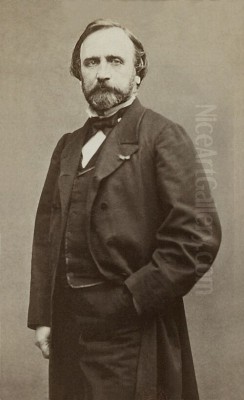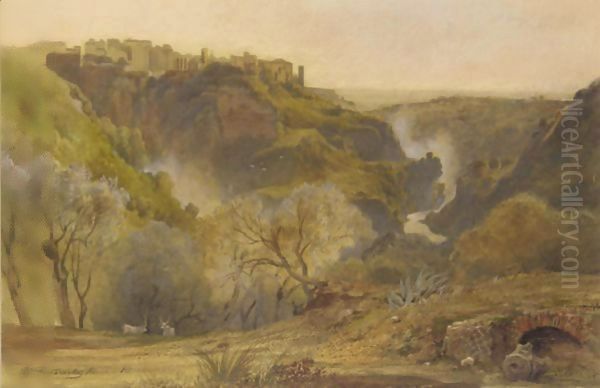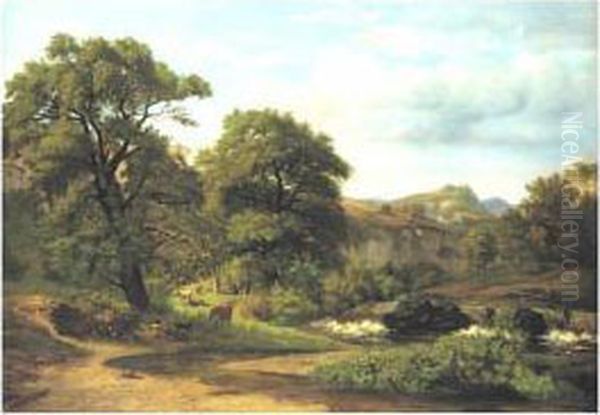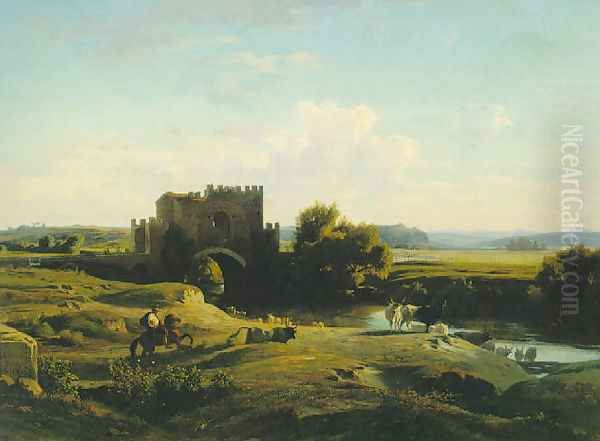
Jean-Achille Benouville stands as a significant, if sometimes overlooked, figure in the landscape of 19th-century French art. A dedicated painter of landscapes, his career bridged the gap between the waning influence of Neoclassicism and the burgeoning movements of Realism and, eventually, Impressionism. His life and work, particularly his long sojourn in Italy, offer a fascinating glimpse into the artistic preoccupations of his era, showcasing a profound sensitivity to light, atmosphere, and the enduring beauty of the natural world, often imbued with a classical sense of order and harmony.
Early Life and Artistic Formation in Paris
Born in Paris on July 15, 1815, Jean-Achille Benouville was immersed in an artistic environment from a young age. He hailed from a family with artistic inclinations; notably, his younger brother, François-Léon Benouville (1821-1859), would also become a respected painter, specializing in historical and religious subjects and, like Jean-Achille, winning the prestigious Prix de Rome. This familial context likely nurtured his early interest in the visual arts.
Benouville's formal artistic training began under the tutelage of established academic painters. He studied with François-Édouard Picot (1786-1868), a painter known for his historical and mythological scenes, portraits, and decorative works, who himself had been a student of Jacques-Louis David and François-André Vincent. Picot, a recipient of the Prix de Rome in 1813, would have instilled in Benouville a strong foundation in academic drawing and composition.
Further honing his skills, Benouville also became a pupil of Léon Cogniet (1794-1880). Cogniet, another prominent figure in the French academic tradition and also a Prix de Rome laureate (1817), was celebrated for his historical paintings and portraits. His studio was a significant training ground for many aspiring artists of the period. Under these masters at the esteemed École des Beaux-Arts in Paris, Benouville received a rigorous classical education, emphasizing meticulous draftsmanship, balanced composition, and the study of Old Masters. This academic grounding would remain a subtle underpinning throughout his career, even as he embraced more naturalistic approaches to landscape.

His official career commenced in 1834 when he made his debut at the Paris Salon, the official art exhibition of the Académie des Beaux-Arts. Exhibiting at the Salon was crucial for any artist seeking recognition and patronage in 19th-century France. Benouville's early submissions primarily consisted of landscapes, indicating his early commitment to this genre.
The Allure of Italy: The Prix de Rome and its Impact
A pivotal moment in Benouville's career arrived in 1845. In that year, he was awarded the coveted Prix de Rome for historical landscape painting. This prestigious prize, established in the 17th century, was the ultimate accolade for young French artists, offering them a funded period of study at the French Academy in Rome, housed in the magnificent Villa Medici. The specific work that secured him this honor was "Ulysses and Nausicaa" (Ulysse et Nausicaä), a composition that skillfully blended classical narrative with a sensitively rendered landscape setting, demonstrating his mastery of the academic requirements for such a subject.
Winning the Prix de Rome was not merely an honor; it was a transformative experience. It provided artists with the opportunity to immerse themselves in the art and culture of Italy, to study firsthand the masterpieces of antiquity and the Renaissance, and to explore the famed Italian landscape that had inspired artists for centuries, from Claude Lorrain and Nicolas Poussin in the 17th century to their own contemporaries.
For Benouville, the journey to Italy was particularly significant as he traveled with, or at least coincided closely in his Italian experience with, Jean-Baptiste-Camille Corot (1796-1875). Corot, already an established and highly influential landscape painter, became a friend and a significant artistic presence for Benouville. Corot's own approach to landscape, characterized by its poetic naturalism, its subtle tonal harmonies, and its emphasis on capturing the fleeting effects of light, would undoubtedly have resonated with and influenced the younger artist. Their shared time in Italy, sketching outdoors and absorbing the unique atmosphere of the Roman Campagna, was formative.
Life and Work in the Italian Peninsula
Benouville's connection to Italy proved to be profound and enduring. He would spend nearly a quarter of a century residing in Rome, from his arrival as a Prix de Rome laureate until his eventual return to Paris in the early 1870s. This extended period allowed him to develop an intimate understanding of the Italian landscape, its light, its colors, and its varied terrains.

During his years in Italy, Benouville became a prolific painter of the Roman Campagna, the Alban Hills, Tivoli, and other picturesque sites that had long attracted artists. His works from this period often depict serene, sun-drenched vistas, ancient ruins integrated into the landscape, and tranquil pastoral scenes. He was particularly adept at capturing the golden light of the Italian countryside, a quality that lent his paintings a warm, inviting atmosphere.
Among his notable works from this period is "View of the Villa Medici Gardens, Rome." This painting, likely created during his stay as a pensionnaire, showcases his ability to combine detailed observation with a harmonious compositional structure. Other works, such as "Tivoli," "Ruins of ancient Roman aqueducts in the Campagna," and "Promenade de la villa Doria à Albano," further attest to his deep engagement with the Italian environment. These paintings often feature carefully rendered architectural elements, lush foliage, and a clear, luminous sky, reflecting both his academic training and his direct observation of nature. He also painted works like "The Vatican seen from the Tiber," capturing iconic Roman views with his characteristic sensitivity.
While in Rome, Benouville was part of a vibrant community of French and international artists. The French Academy served as a hub, but artists also interacted in cafes and on sketching expeditions. He would have been aware of other French landscape painters working in Italy, as well as Italian artists who were themselves exploring new directions in landscape painting, such as those associated with the burgeoning Macchiaioli movement, though their style was markedly different.
Artistic Style and Evolution: From Classicism to Naturalism
Jean-Achille Benouville's artistic style evolved throughout his career, reflecting broader shifts in 19th-century art. He began firmly rooted in the classical landscape tradition, which emphasized idealized scenery, balanced compositions, and often incorporated historical or mythological figures, as seen in his Prix de Rome entry. This tradition, inherited from artists like Claude Lorrain and Poussin, valued order, clarity, and a certain timeless grandeur.
However, his extended exposure to the Italian landscape and his interactions with artists like Corot encouraged a move towards greater naturalism. While his compositions often retained a classical sense of structure and harmony, his handling of light and color became more nuanced and observational. He developed a keen sensitivity to atmospheric effects, capturing the subtle gradations of light at different times of day and in various weather conditions. This focus on the direct experience of nature aligned him with the broader trend towards Realism that was gaining momentum in France, championed by artists like Gustave Courbet (1819-1877).

Benouville's style can be seen as a bridge. He did not fully embrace the radicalism of Courbet, nor did he anticipate the broken brushwork and optical color theories of the Impressionists like Claude Monet (1840-1926) or Camille Pissarro (1830-1903). Instead, he carved out a niche for himself, creating landscapes that were both faithful to nature and imbued with a poetic sensibility. His work often exhibits a calm, contemplative mood, a love for the picturesque, and a mastery of traditional painting techniques.
The influence of the Barbizon School can also be discerned in his approach, particularly in his dedication to capturing the specific character of a place. Artists like Théodore Rousseau (1812-1867), Jean-François Millet (1814-1875), Charles-François Daubigny (1817-1878), Constant Troyon (1810-1865), Narcisse Virgilio Díaz de la Peña (1807-1876), and Jules Dupré (1811-1889), who painted in the Forest of Fontainebleau near Paris, emphasized direct observation from nature and a more personal, less idealized vision of the landscape. While Benouville's primary focus was Italy, the Barbizon ethos of truth to nature and the importance of light and atmosphere resonated with his own artistic inclinations. His paintings, with their soft tones, harmonious color palettes, and careful attention to detail, reflect this mid-century shift towards a more naturalistic and less overtly narrative form of landscape art.
His "Pastoral Landscape," for example, demonstrates this blend: the idyllic subject matter harks back to older traditions, but the treatment of light and shadow, and the overall atmosphere, speak to a more contemporary, naturalistic sensibility. He was skilled in using chiaroscuro, the play of light and dark, to create depth and mood, often bathing his scenes in a gentle, diffused light that softened contours and unified the composition.
Key Works and Their Characteristics
Several works stand out in Jean-Achille Benouville's oeuvre, illustrating the key characteristics of his style.
"Ulysses and Nausicaa" (1845), his Prix de Rome painting, is a prime example of the historical landscape. It required the artist to integrate a narrative from classical literature into a convincing natural setting. Benouville succeeded by creating a balanced composition where the figures, though central to the story, are harmoniously situated within a meticulously rendered landscape that evokes the Mediterranean world of Homer's epic. The trees, rocks, and distant sea are painted with a clarity and precision that reflect his academic training, while the overall mood is one of serene classicism.
"View of the Villa Medici Gardens, Rome" offers a more intimate and directly observed scene. Here, the focus is on the beauty of the gardens themselves, with their characteristic Italian cypresses, stone pines, and architectural elements. The play of sunlight and shadow across the foliage and pathways is a key feature, demonstrating Benouville's growing interest in capturing specific atmospheric conditions. The composition is ordered but feels natural, inviting the viewer to step into the tranquil space.
"The Vatican seen from the Tiber" is a classic Roman view, a subject tackled by many artists. Benouville's rendition would likely emphasize the majestic presence of St. Peter's Basilica and the Vatican complex, perhaps bathed in the warm light of late afternoon. His skill would lie in balancing the iconic architecture with the natural elements of the river and its banks, creating a harmonious whole that is both topographically accurate and aesthetically pleasing.
His numerous paintings of the Roman Campagna, such as "Ruins of ancient Roman aqueducts in the Campagna," capture the unique character of this historic landscape. These works often feature the crumbling remains of Roman structures set against expansive plains and distant mountains. Benouville was adept at conveying the sense of history and melancholy that pervades these scenes, while also celebrating their enduring natural beauty. The light in these paintings is often clear and bright, typical of the Italian climate.
In "Pastoral Landscape," the emphasis is on a bucolic, idyllic scene, perhaps featuring shepherds and their flocks. Such works connect to a long tradition of pastoral art, but Benouville's interpretation would be infused with his naturalistic observations of light, foliage, and animal forms. The mood is typically one of peace and harmony with nature.
Throughout these works, common threads emerge: a strong sense of composition, often with a classical balance; a keen observation of natural detail; a sophisticated understanding and rendering of light and atmosphere; and a preference for serene, harmonious scenes. His color palette tends to be rich but controlled, with an emphasis on earthy tones, lush greens, and luminous blues for the sky.
Recognition, Later Career, and Contemporaneous Interactions
Even while based in Italy, Jean-Achille Benouville continued to maintain his presence in the Parisian art world by regularly submitting works to the Salon. His paintings were generally well-received, appreciated for their technical skill, their pleasing subject matter, and their blend of classical order with naturalistic observation. In 1863, his contributions to French art were officially recognized when he was made a Chevalier of the Legion of Honour, a significant mark of distinction.
His long association with Corot was undoubtedly one of his most important artistic relationships. Corot's own Italian sojourns had profoundly shaped his art, and his ability to imbue landscapes with a lyrical, poetic quality, often through subtle tonal modulations and a soft, feathery brushwork in his later period, set him apart. While Benouville's style remained somewhat more precise and detailed than Corot's more mature, evocative works, the shared experience of painting outdoors in Italy and the mutual respect between the two artists were clearly influential.
Beyond Corot, Benouville's teachers, Picot and Cogniet, represented the established academic tradition. Their influence provided him with the technical grounding necessary for a successful career within the Salon system. His brother, François-Léon, though focused on different subject matter, shared a similar artistic education and the experience of Rome, creating a familial artistic dialogue.
The broader artistic environment included figures like Jean-Auguste-Dominique Ingres (1780-1867), a towering figure of French Neoclassicism and a former director of the French Academy in Rome, whose emphasis on line and classical form set a standard for academic art. While Benouville was a landscape painter, the prevailing aesthetic ideals championed by Ingres would have been part of the artistic discourse. Similarly, the Romantic landscapes of artists like Paul Huet (1803-1869), with their more dramatic and emotionally charged depictions of nature, offered a contrast to Benouville's calmer, more classical temperament, though Romanticism's general appreciation for nature's grandeur was a shared sentiment.
The rise of Realism with Courbet challenged the idealized conventions of academic art, advocating for the depiction of ordinary life and unvarnished reality. While Benouville did not adopt Courbet's often confrontational subject matter or his robust, impasto technique, the Realist emphasis on truth to nature likely reinforced his own commitment to careful observation in his landscapes.
In the later part of his career, the Impressionist movement began to revolutionize landscape painting. Artists like Monet, Pissarro, Alfred Sisley (1839-1899), and Pierre-Auguste Renoir (1841-1919) pushed the boundaries of capturing fleeting moments, the effects of light and color, often with broken brushwork and a focus on subjective visual experience. Benouville, belonging to an earlier generation, did not embrace these radical innovations, but his own dedication to observing and rendering light can be seen as part of the broader 19th-century exploration of landscape that paved the way for Impressionism. He remained more aligned with a tradition of naturalistic landscape that sought to balance observation with pictorial harmony, a path also trodden by artists like Henri-Joseph Harpignies (1819-1916), who, like Benouville, had a long career and was deeply influenced by Italy and Corot.
Benouville eventually returned to Paris in the early 1870s, after the fall of the Second Empire and the turmoil of the Franco-Prussian War and the Paris Commune. He continued to paint and exhibit, though the artistic landscape in France was rapidly changing.
Legacy and Influence
Jean-Achille Benouville passed away in Paris in February 1891. He left behind a substantial body of work, primarily landscapes that celebrate the beauty of the Italian and, to a lesser extent, French countryside. His paintings are characterized by their technical proficiency, their sensitivity to light and atmosphere, and their harmonious compositions.
While he may not have achieved the revolutionary fame of some of his contemporaries, Benouville played a valuable role in the evolution of 19th-century landscape painting. He successfully navigated the transition from a more rigid classicism towards a greater naturalism, absorbing influences from artists like Corot and the general spirit of the Barbizon School, without abandoning the structural coherence and elegance learned from his academic training. His work represents a refined and appealing form of naturalistic landscape that found favor with the Salon juries and the art-buying public of his time.
His paintings are held in the collections of numerous museums, including prestigious institutions such as the Louvre Museum and the Musée d'Orsay in Paris, and the Metropolitan Museum of Art in New York, as well as many French provincial museums. These holdings ensure that his contribution to art history is preserved and accessible for study.
Benouville's legacy lies in his dedication to the genre of landscape painting and his ability to capture the unique character and luminous beauty of the Italian scenery. He was part of a long lineage of French artists drawn to Italy, and his works provide a valuable record of its landscapes as seen through the eyes of a skilled and sensitive 19th-century painter. He influenced subsequent landscape painters through his example of careful observation combined with poetic sensibility, contributing to the rich tradition of French landscape art that continued to flourish into the 20th century. His art reminds us of a period when the direct study of nature, filtered through a classical sensibility, could produce works of enduring charm and quiet beauty.
Conclusion
Jean-Achille Benouville was a distinguished French landscape painter whose career spanned a period of significant artistic change. From his academic training in Paris to his transformative years in Italy, he developed a style that gracefully blended classical principles with a naturalistic approach to light and atmosphere. His award of the Prix de Rome was a testament to his early talent, and his long residency in Italy allowed him to produce a rich body of work celebrating its famed landscapes. Influenced by masters like Corot and responsive to the broader currents of Realism and the Barbizon School, Benouville created paintings that are admired for their technical skill, harmonious compositions, and serene beauty. Though perhaps not a radical innovator, he was a master of his craft, and his works continue to be appreciated for their sensitive depiction of nature and their embodiment of a refined artistic vision. His contributions ensure his place as an important figure in the story of 19th-century European landscape painting.